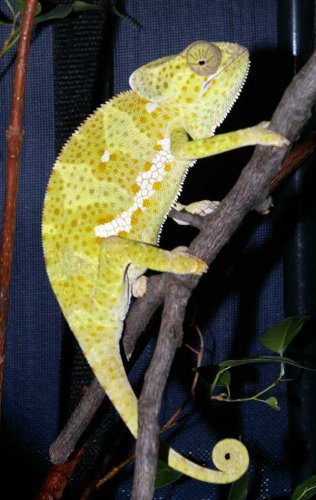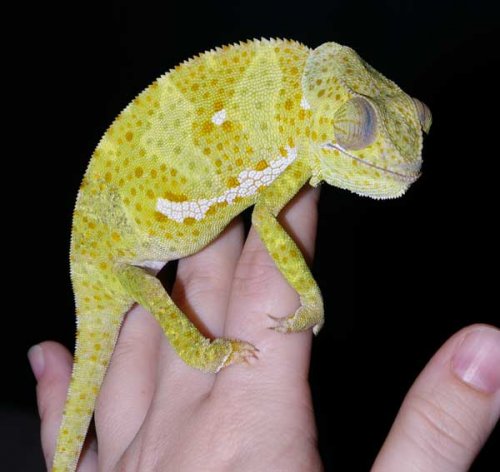Navigation
Install the app
How to install the app on iOS
Follow along with the video below to see how to install our site as a web app on your home screen.
Note: This feature may not be available in some browsers.
More options
You are using an out of date browser. It may not display this or other websites correctly.
You should upgrade or use an alternative browser.
You should upgrade or use an alternative browser.
a lil help please
- Thread starter apple
- Start date
Are the two in the same cage? If so, this will mean that they will likely mate as soon as they are sexually mature. I never mate a female until she is full grown.
Also, its not usually a good idea to keep a pair of chameleons in the same cage depending on the species...and flaps are one species I would only keep singly.
Just my 2 cents worth...
For all egglaying females, I always put a container of washed sandbox sand in the cage once sexually mature so that the females can dig to lay their eggs. That way I don't have to watch for the often subtle signs that they are ready to lay eggs. If there is no place for them to lay they will likely end up eggbound and die.
Also, its not usually a good idea to keep a pair of chameleons in the same cage depending on the species...and flaps are one species I would only keep singly.
Just my 2 cents worth...
For all egglaying females, I always put a container of washed sandbox sand in the cage once sexually mature so that the females can dig to lay their eggs. That way I don't have to watch for the often subtle signs that they are ready to lay eggs. If there is no place for them to lay they will likely end up eggbound and die.
From what I have read...to tell if she is gravid...The females become sexually mature at about 9 months of age.
When close to laying the female will become restless and roam the cage looking for a place to lay the eggs. Some stop eating...but this partly depends on the number of eggs they are carrying.
There is usually one clutch produced per year about 3 months after mating. Eggs can take up to a year to hatch in the wild but can take as little as 5 months in captivity. They are laid in a hole up to 30 cm deep.
You might like to read these threads...
https://www.chameleonforums.com/flap-neck-eggs-2026/
https://www.chameleonforums.com/flapneck-egg-laying-2980/
When close to laying the female will become restless and roam the cage looking for a place to lay the eggs. Some stop eating...but this partly depends on the number of eggs they are carrying.
There is usually one clutch produced per year about 3 months after mating. Eggs can take up to a year to hatch in the wild but can take as little as 5 months in captivity. They are laid in a hole up to 30 cm deep.
You might like to read these threads...
https://www.chameleonforums.com/flap-neck-eggs-2026/
https://www.chameleonforums.com/flapneck-egg-laying-2980/
Tygerr
Avid Member
In the wild they usually occupy territories as large as a tree, or even a whole grove of trees. 72 inches is not very big by comparison.i have a very tall reterium its like 72 inches tall they barly see eachother in there...
You should have the two chameleons in separate enclosures.
Fate X
New Member
i never had flapnecks but i been breeding some veileds.the process is not easy in my opinion.
i started the hobby in feb 2006,i started with babies though.
i just had the first hatchlings hatch on memorial day this year there were 26 veileds.the chameleons gotta be kinda healthy to breed .
if i was you i would upgrade to a zoomed 5.0 flourescent tube bulb then setup a drainage system then you will have the water under control thats important.then the rest of the other stuff.these veileds love the water it seems .
do the flapnecks need mist 30mn a day? i mean you might have to mist them 2x20mn a day.
i started the hobby in feb 2006,i started with babies though.
i just had the first hatchlings hatch on memorial day this year there were 26 veileds.the chameleons gotta be kinda healthy to breed .
if i was you i would upgrade to a zoomed 5.0 flourescent tube bulb then setup a drainage system then you will have the water under control thats important.then the rest of the other stuff.these veileds love the water it seems .
do the flapnecks need mist 30mn a day? i mean you might have to mist them 2x20mn a day.
If you read the link I gave you there is a description of the size of container I put in egglaying females' cages...and what I do after they start to dig in these containers that are sometimes to small for them to actually lay their eggs in. These small containers I leave in the cage are meant to give the female a place to dig to indicate that she is ready to lay eggs (although some species will lay their eggs in the small ones) before I move the female to the egglaying bin I described.
Like many species of chameleon, when a receptive female meets a male they will mate....so breeding a receptive pair could be considered easy. If the female isn't receptive (or already is gravid) she will turn dark and hiss and sway and show all the signs of being non-receptive/gravid. If the male comes close enough she will likely attack him.
Once they have mated and the female is gravid, she will begin to repel the male by her colors and actions...and his presence in the cage will stress her out.
During the time between becoming gravid and laying the eggs the chameleon will need to be well looked after so that she will be strong enough to lay the eggs and so that they eggs will be healthy too.
Once she is gravid, you still have to get through the egglaying...which is NOT as easy as getting them to mate. The female needs what SHE considers to be a suitable place to lay them. She has to be healthy enough to lay them.
If you get through that, you still have to incubate the eggs in a suitable fashion that they will get what they need to survive to the point of hatching.
You said in a separate thread that the male was staying in one area of the cage and the female in another....she is likely "stuck" there...if she moves the male will see her so to stay out of the male's sight/attention she has to stay there. If you keep her under that type of constant stress, her immune system will drop and she could die.
You said they were 5 - 8 inches long....snout to vent or snout to tail tip??
What color is the female showing?
Like many species of chameleon, when a receptive female meets a male they will mate....so breeding a receptive pair could be considered easy. If the female isn't receptive (or already is gravid) she will turn dark and hiss and sway and show all the signs of being non-receptive/gravid. If the male comes close enough she will likely attack him.
Once they have mated and the female is gravid, she will begin to repel the male by her colors and actions...and his presence in the cage will stress her out.
During the time between becoming gravid and laying the eggs the chameleon will need to be well looked after so that she will be strong enough to lay the eggs and so that they eggs will be healthy too.
Once she is gravid, you still have to get through the egglaying...which is NOT as easy as getting them to mate. The female needs what SHE considers to be a suitable place to lay them. She has to be healthy enough to lay them.
If you get through that, you still have to incubate the eggs in a suitable fashion that they will get what they need to survive to the point of hatching.
You said in a separate thread that the male was staying in one area of the cage and the female in another....she is likely "stuck" there...if she moves the male will see her so to stay out of the male's sight/attention she has to stay there. If you keep her under that type of constant stress, her immune system will drop and she could die.
You said they were 5 - 8 inches long....snout to vent or snout to tail tip??
What color is the female showing?
yes i dont understand why she is always there she eats well drinks well i actually hand fed her she was eating very well but the male was scared to eat from my hand andways so shes basically always there and she goes lower then bac to the spot its like her sweet spot also after i read what u wrote about the color i took these pix this is her color




Brandy
New Member
your female does not look receptive i think delipis are seasonal breeder having one mabey 2 clutches a year from what i have experienced, i would not keep them together at all aside from matting attempts i find these chams do not do well at all when kept in sight of each other especially the males. Iv attached 2 pictures of my female she goes this amazing yellow when receptive, otherwise is green. this receptive coloration seems to last about 2 weeks.
In addition i have never seen the dark marks on my flap is this a response from the male if so i would assume this is a very unresponsive coloration.
In addition i have never seen the dark marks on my flap is this a response from the male if so i would assume this is a very unresponsive coloration.
Attachments
Last edited:
Dean Pulcini
Avid Member
I don't like the way that mouth looks.
Similar threads
- Replies
- 5
- Views
- 2K





